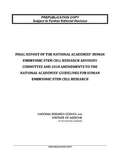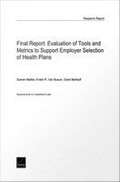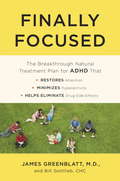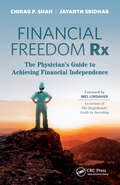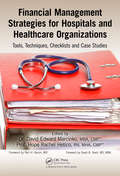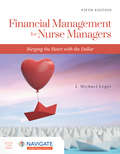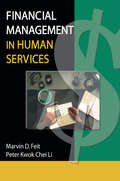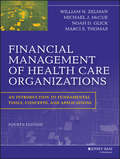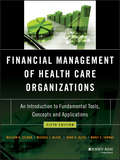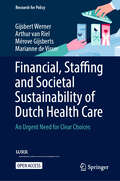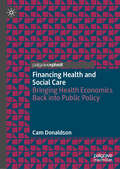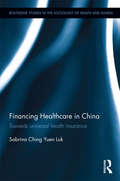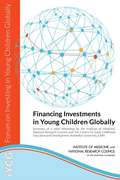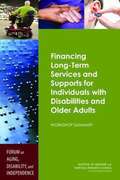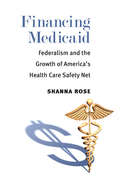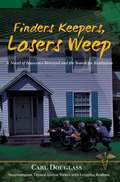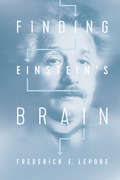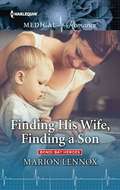- Table View
- List View
Final Report of the National Academies' Human Embryonic Stem Cell Research Advisory Committee and 2010 Amendments to the National Academies' Guidelines for Human Embryonic Stem Cell Research
by National Research Council Institute of Medicine of the National AcademiesIn 2005, the National Academies released the book, Guidelines for Human Embryonic Stem Cell Research, which offered a common set of ethical standards for a field that, due to the absence of comprehensive federal funding, was lacking national standards for research. In order to keep the Guidelines up to date, given the rapid pace of scientific and policy developments in the field of stem cell research, the Human Embryonic Stem Cell Research Advisory Committee was established in 2006 with support from The Ellison Medical Foundation, The Greenwall Foundation, and the Howard Hughes Medical Institute. As it did in 2007 and 2008, the Committee identified issues that warranted revision, and this book addresses those issues in a third and final set of amendments. Specifically, this book sets out an updated version of the National Academies' Guidelines, one that takes into account the new, expanded role of the NIH in overseeing hES cell research. It also identifies those avenues of continuing National Academies' involvement deemed most valuable by the research community and other significant stakeholders.
Final Report: Evaluation of Tools and Metrics to Support Employer Selection of Health Plans
by Soeren Mattke Kristin R. Van Busum Grant MartsolfThe Patient Protection and Affordable Care Act (ACA) places strong emphasis on quality of care as a means to improve outcomes for Americans and promote the financial sustainability of our health care system. Included in the ACA are new disclosure requirements that require health plans to provide a summary of benefits and coverage that accurately describes the benefits under the plan or coverage. These requirements are intended to support employers' procurement of high-value health coverage for their employees. This report attempts to help employers understand the structural differences between health plans and the performance dimensions along which plans can differ, as well as to educate employers about available tools that can be used to evaluate plan options. The report also discusses the extent to which these and other tools or resources are used by employers to inform choices between health plans.
Finally Focused: The Breakthrough Natural Treatment Plan for ADHD That Restores Attention, Minimizes Hyperactivity, and Helps Eliminate Drug Side Effects
by Bill Gottlieb James GreenblattDISCOVER THE ADHD SOLUTION FOR YOUR CHILDDr. James Greenblatt has seen thousands of children and adults struggling with the symptoms of ADHD – hyperactivity, inattentiveness, impulsiveness, and often irritability and combativeness. Rather than simply prescribing medication for their ADHD symptoms, he tailors remedies to his patients’ individual needs, detecting and treating the underlying causes of the disorder. Finally Focused provides proven natural and medical methods to easily treat problems such as nutritional deficiencies or excesses, dysbiosis (a microbial imbalance inside the body), sleeping difficulties, and food allergies, all of which surprisingly can cause or worsen the symptoms of ADHD. Using Dr. Greenblatt’s effective Plus-Minus Healing Plan, parents will first understand the reasons behind their child's symptoms, and then be able to eliminate them by addressing the child’s unique pattern of biological weakness. Adults with ADHD can do the same for themselves. And if conventional medication is still necessary, this integrative approach will minimize or even eliminate troublesome side effects. Using Dr. Greenblatt’s expert advice, millions of children and adults with ADHD finally will get the help they need to achieve true wellness.
Finance, Innovation and Geography: Harnessing Knowledge Dynamics in German Biotechnology (Routledge Studies in Innovation, Organizations and Technology)
by Felix C. MüllerThe overarching aim of Finance, Innovation and Geography: Harnessing Knowledge Dynamics in German Biotechnology is to explore linkages between geographies of finance and relational geographies of innovation. This is achieved by questioning how investment activities affect the unfolding of innovations and in turn are affected by it. This book focuses on biotechnology innovation processes from the perspective of relational economic geography. It reconstructs the unfolding in time and space of eight innovations in German biotechnology. Each one is represented in a qualitative case study. The analysis focuses on the relational work of building, transforming, ending and replacing of collaborative relationships and organizational arrangements surrounding emergent innovations ・ including investment relations and relational work by investors. In this way, the contribution of investors to unfolding innovations is studied with sensitivity to context and situated interactions. The geography of these dynamics is conceptualized by drawing on the recent literature on relational proximity and distance as well as ideas of materiality and space. This book provides a unique perspective, and shows that innovation paths are strongly interwoven with local and temporary opportunities as well as crises, and that investment is embedded in these dynamics. This is essential reading for students and academics of both economics and innovation.
Financial Freedom Rx: The Physician’s Guide to Achieving Financial Independence
by Chirag Shah Jayanth Sridhar"The best physician-specific general financial book published in 2021." —James M. Dahle, MD, author of The White Coat InvestorA step-by-step guidebook for doctors and other medical professionals about growing and preserving wealth, Financial Freedom Rx: The Physician’s Guide to Achieving Financial Independence gives physicians all the tools necessary to manage their own finances and includes a foreword by Mel Lindauer, co-author of The Bogleheads' Guide to Investing. Medical professionals, especially doctors, spend many years in training as they accumulate debt and delay their earnings. This book presents a time-tested formula that students and established professionals can follow at any stage during their careers to achieve fiscal peace of mind. Students will learn how to budget and adopt disciplined financial practices. Residents and other trainees will learn how to defend against calamity with various insurances and how to manage debt. Junior professionals will acquire the skills needed to invest and grow their portfolios, while senior professionals will better understand the essentials of estate planning and retirement. Drs. Chirag P. Shah and Jayanth Sridhar wrote this inspiring text to guide physicians where to put their next dollar. This is particularly important during the financial uncertainties brought on by COVID-19 and insurance cuts. Financial Freedom Rx sets forth principles that will pilot medical professionals toward financial independence. Chapters include useful advice on topics such as: Financial planning Investing and asset allocation Jobs and contracts Taxes and insurance Student loans and debt Retirement savings and distributions Financial Freedom Rx: The Physician’s Guide to Achieving Financial Independence serves as a timeless blueprint for financial planning that medical professionals will follow throughout their careers, and as a reference that readers will revisit again and again as they progress through the various stages of life.
Financial Management Strategies for Hospitals and Healthcare Organizations: Tools, Techniques, Checklists and Case Studies
by David Edward Marcinko Hope Rachel HeticoIn this book, a world-class editorial advisory board and an independent team of contributors draw on their experience in operations, leadership, and Lean managerial decision making to share helpful insights on the valuation of hospitals in today‘s changing reimbursement and regulatory environments.Using language that is easy to understand, Financia
Financial Management for Nurse Managers: Merging the Heart with the Dollar
by J. Michael LegerFinancial Management for Nurse Managers: Merging the Heart with the Dollar, Fifth Edition is a unique text that addresses the financial management issues faced by nurse leaders in a variety of settings, including hospitals, ambulatory/outpatient clinics, long-term care facilities, and home care. With an evidence-based and practical approach, it covers a wide-range of financial information, including healthcare finance, economics, budgeting, reimbursements, accounting, and financial strategies. The Fifth Edition features additional ambulatory examples, a new exercise on emergency planning, and updated and expanded case studies. Financial Management for Nurse Managers: Merging the Heart with the Dollar brings financial concepts to life for students with practical applications and straightforward budgeting practice activities.
Financial Management in Human Services
by Marvin D Feit Peter K LiRather than treating financial management as an independent administrative practice, Financial Management in Human Services provides students and social service administrators with a conceptual framework in which financial management is the major responsibility of an administration, not just a separate practice. This text describes how the integration of administrative practice with fiscal responsibility and accountability will help you plan better programs, account for all fiscal transactions, and coordinate and evaluate services more effectively.Containing many different approaches on how to determine costs, obtain information, and collect data, this text will help you clearly evaluate your organization’s progress and determine if your program goals are being reached. Financial Management in Human Services also discusses other topics related to efficient management, including: applying financial management techniques to the areas of program planning, service monitoring, estimating service and unit costs, and setting future service priorities in order to make better business decisions utilizing the information generated from the Financial Management System (FMS) to improve administrative functions, such as forecasting and goal determination, activity flow and service provision monitoring, and service planning according to program policy examining the importance of the four administrative subsystems-- budgeting and accounting, service coordination, program planning, and program evaluation choosing a FMS with consideration to certain factors, such as availability of information and identifying informational needs of the administration listing of reactive and proactive types of financial reports that help administrators evaluate the costs of services provided and identify problems in balancing the fiscal budget using methods such as a line item analysis to accurately compute the costs of staff involvement in a programThis organized, straightforward text will help you evaluate all costs-- from salaries, travel time, and office supplies to direct costs to make your office more organized and productive. Complete with questions and answers about starting and maintaining a FMS, Financial Management in Human Services will enable you to manage finances more efficiently, making it easier for you to reach and set goals that better serve your clients.
Financial Management of Health Care Organizations
by Marci S. Thomas Noah D. Glick William N. Zelman Michael J. MccueThis new Fourth Edition of Financial Management of Health Care Organizations, offers an introduction to the most-used tools and techniques of health care financial management, including health care accounting and financial statements; managing cash, billings and collections; making major capital investments; determining cost and using cost information in decision-making; budgeting and performance measurement; and pricing.New to this edition: The Perspectives sections and the glossary have been updated. The book features a cutting-edge view of the health care landscape in 2013 and beyond after passage and pending implementation of the Affordable Care Act. Areas of expanded content include revised examples of financial statements for both private non-profit hospitals and investor-owned hospital management companies, changes in bad debt and charity care, the role of financial statements, the discount rate or cost of capital, lease financing section, use of cost information, budgeting, cost centers, and current forms of reimbursement Content new to this edition includes valuation of accounts receivable and the "waterfall" effect of cash collections, differences between Posting-Date and Service-Date reporting methodologies, calculation of effective annual interest rate, application of time value of money in perspectives, and Activity-Based Costing from the perspective of labor, supplies, and equipment.
Financial Management of Health Care Organizations: An Introduction to Fundamental Tools, Concepts and Applications
by Marci S. Thomas Noah D. Glick William N. Zelman Michael J. McCueThis thoroughly revised and updated Fifth Edition of Financial Management of Health Care Organizations offers an introduction to the tools and techniques of health care financial management. The book covers a wide range of topics, including information on the health care system and evolving reimbursement methodologies; health care accounting and financial statements; managing cash, billings, and collections; the time value of money and analyzing and financing major capital investments; determining cost and using cost information in decision-making; budgeting and performance measurement; and pricing. The revised edition covers new accounting changes for nonprofit hospitals with respect to net asset accounts, and includes an array of new financial statement problem sets for nonprofit hospitals. These changes also required major changes to the recording of financial transactions and implementing the latest financial ratio benchmarks. With the newest payment developments in the health care landscape, this new edition updates changes to Medicare and commercial payment systems. The passage of the new tax law also impacted hospital capital markets and for-profit hospital tax rates. This latest edition explains the impact of this tax law change on tax-exempt hospital bonds purchased by banks, as well as presenting problem sets featuring the new taxes law. Finally, changes in lease financing reporting are also addressed in this edition.
Financial, Staffing and Societal Sustainability of Dutch Health Care: An Urgent Need for Clear Choices (Research for Policy)
by Mérove Gijsberts Gijsbert Werner Arthur van Riel Marianne de VisserThis open access book analyzes how sound choices can be made in Dutch health care policies, and shows why they are necessary, urgent, and even inevitable. Analyzing the current functioning and funding of the Dutch health care system, this book shows how three dimensions of sustainability – financial, staffing and societal – are under increasing pressure. This study explores priority setting in health care and calls for well-informed, clear and sometimes uncompromising choices in the allocation of means and personnel. This is necessary in order to maintain accessible and high-quality care for all, and to improve public health. Making balanced choices in health care is of particular importance to vulnerable groups whose voices may not be heard as readily or effectively in the public debate, and whose interests are more easily crowded out. Prioritizing in the domain of public health care is first and foremost a political responsibility, but also one for health care providers across the system and ultimately also for citizens. While this work focuses on the Netherlands, similar processes are at play across the developed economies, making it broadly relevant to policy makers, health care professionals and health care (policy) researchers grappling with the questions surrounding the sustainability of public health care.
Financing Health and Social Care: Bringing Health Economics Back into Public Policy
by Cam DonaldsonWhy do most capitalist economies have socialist health care systems? How can we preserve them? What would Aneurin Bevan think? These are the three main questions addressed by this book. In the 1950s, through In Place of Fear, Bevan made a strong case for a National Health Service which he had been instrumental in establishing in the UK in 1948. But he did not articulate the accompanying economic case. That case is presented here in an accessible way and extended to social care. A comprehensive understanding of &‘tried and tested&’ means of financing health care is presented, alongside assessments of repeated and new approaches proposed in policy circles as quick fixes to funding shortfalls. This is tackled across four themes: the role of the private sector; making choices in the face of resource scarcity; workforce planning and remuneration; and preparation for pandemics. The emerging proposals carry a cost to the public purse, but must be weighed against the costs and unfairness of further disintegration. With a special focus on the UK and the NHS at a critical time for policy change, this essential book provides the blueprint for policymakers, clinical leadership and politicians needing to pay more attention to the economic issues underlying health and social care as they shape In Place of Fear 2.0.
Financing Healthcare in China: Towards universal health insurance
by Sabrina Ching LukChina’s current social medical insurance system has nominally covered more than 95 per cent of 1.4 billion population in China and is moving towards the ambitious goal of universal health insurance coverage. Challenges posed by a rapidly ageing population, an inherently discriminatory design of the health insurance system, the disorder of drug distribution system and an immature legal system constrain the Chinese government from realizing its goal of universal health insurance coverage in the long run. This book uses a refined version of historical institutionalism to critically examine China's pathway to universal health insurance coverage since the mid-1980s. It pays crucial attention to the processes of transforming China's healthcare financing system into the basic social medical insurance system alongside rapid socio-economic changes. Financing Healthcare in China will interest researchers and government and think-tank officials interested in the state of healthcare reforms in China. Healthcare specialists outside of East Asia may also be interested in its general study of healthcare in developing countries. Scholars and students interested in the healthcare field will also find this useful.
Financing Investments in Young Children Globally: Summary of a Joint Workshop by the Institute of Medicine, National Research Council, and The Centre for Early Childhood Education and Development, Ambedkar University, Delhi
by Deepali M. PatelIn January 2014, the Board on Children, Youth, and Families of the Institute of Medicine and the National Research Council, in collaboration with the IOM Board on Global Health, launched the Forum on Investing in Young Children Globally. At this meeting, the participants agreed to focus on creating and sustaining, over 3 years, an evidence-driven community of stakeholders that aims to explore existing, new, and innovative science and research from around the world and translate this evidence into sound and strategic investments in policies and practices that will make a difference in the lives of children and their caregivers. Financing Investments in Young Children Globally is the summary of a workshop hosted by the Forum on Investing in Young Children Globally in August 2014. This workshop, on financing investments for young children, brought together stakeholders from such disciplines as social protection, nutrition, education, health, finance, economics, and law and included practitioners, advocates, researchers, and policy makers. Presentations and discussions identified some of the current issues in financing investments across health, education, nutrition, and social protection that aim to improve children's developmental potential. This report explores issues across three broad domains of financing: (1) costs of programs for young children; (2) sources of funding, including public and private investments; and (3) allocation of these investments, including cash transfers, microcredit programs, block grants, and government restructuring.
Financing Long-Term Services and Supports for Individuals with Disabilities and Older Adults
by Tracy A. Lustig"Financing Long-Term Services and Supports for Individuals with Disabilities and Older Adults" is the summary of a workshop convened in June 2013 by the Forum on Aging, Disability, and Independence of the Institute of Medicine and the National Research Council to examine the financing of long-term services and supports for working-age individuals with disabilities and among individuals who are developing disabilities as they age. The workshop covered both older adults who acquire disabilities and younger adults with disabilities who may acquire additional impairments as they age, the target population of the Forum's work. The challenges associated with financing long-term services and supports for people with disabilities impacts all age groups. While there are important differences between the characteristics of programs developed for different age groups, and specific populations may have different needs, this workshop addressed the financing sources for long-term services and supports in general, noting specific differences as appropriate. The financing of long-term services and supports has become a major issue in the United States. These are the services and supports that individuals with disabilities, chronic conditions, and functional impairments need in order to live independently, such as assistance with eating, bathing, and dressing. Long-term services and supports do not include the medical or nursing services required to manage health conditions that may be responsible for a disabling condition. At least 11 million adults ages 18 and over receive long-term services and supports. Only a little more than half of them - 57 percent - are ages 65 or older. One study found that about 6 percent of people turning 65 in 2005 could expect to have expenses of more than $100,000 for long-term services and supports. "Financing Long-Term Services and Supports for Individuals with Disabilities and Older Adults" discusses the scope and trends of current sources of financing for long-term services and supports for working-age individuals with disabilities and older adults aging into disability, including income supports and personal savings. This report considers the role of families, business, and government in financing long-term services and supports and discusses implications of and opportunities for current and innovative approaches.
Financing Medicaid: Federalism and the Growth of America's Health Care Safety Net
by Shanna RoseConventional wisdom holds that programs for the poor are vulnerable to instability and retrenchment. Medicaid, however, has grown into the nation's largest intergovernmental grant program, accounting for nearly half of all federal funding to state and local governments. Medicaid's generous open-ended federal matching grants have given governors a powerful incentive to mobilize on behalf of its maintenance and expansion, using methods ranging from lobbying and negotiation to creative financing mechanisms and waivers to maximize federal financial assistance. Perceiving federal retrenchment efforts as a threat to states' finances, governors, through the powerful National Governors' Association, have repeatedly worked together in bipartisan fashion to defend the program against cutbacks. Financing Medicaidengagingly intertwines theory, historical narrative, and case studies, drawing on sources including archival materials from the National Governors' Association and gubernatorial and presidential libraries, Centers for Medicare and Medicaid Services data, the Congressional Record, and interviews.
Financing Population Health Improvement: Workshop Summary
by Joe AlperDespite spending far more on medical care than any other nation and despite having seen a century of unparalleled improvement in population health and longevity, the United States has fallen behind many of its global counterparts and competitors in such health outcomes as overall life expectancy and rates of preventable diseases and injuries. A fundamental but often overlooked driver of the imbalance between spending and outcomes is the nation\'s inadequate investment in non-clinical strategies that promote health and prevent disease and injury population-wide, strategies that fall under the rubric of "population health. " Given that it is unlikely that government funding for governmental public health agencies, whether at the local, state, or federal levels, will see significant and sustained increases, there is interest in finding creative sources of funding for initiatives to improve population health, both through the work of public health agencies and through the contributions of other sectors, including nonhealth entities. Financing Population Health Improvement is the summary of a workshop convened by the Institute of Medicine Roundtable on Population Health Improvement in February 2014 to explore the range of resources that might be available to provide a secure funding stream for non-clinical actions to enhance health. Presenters and participants discussed the range of potential resources (e. g. , financial, human, and community) explored topics related to financial resources. This report discusses return on investment, the value of investing in population-based interventions, and possible sources of funding to improve population health.
Finanzierung und Organisation des Sozialstaates
by Ralf MöllerDieses Lehrbuch bietet eine Darstellung der Finanzierungs- und Organisationsstruktur des deutschen Sozialstaates mit einem Schwerpunkt im Bereich der Sozialversicherung. Es stellt die Organisationsformen sozialstaatlicher Verwaltungen in Grundzügen mit zahlreichen Beispielen auf Bundes-, Landes- sowie kommunaler Ebene vor. Dabei werden Gestaltungsmöglichkeiten von Organisationsstrukturen und aktuelle Rechtsfragen erörtert. Ein weiterer Schwerpunkt ist die Finanzierung sozialstaatlicher Leistungen. Im Mittelpunkt stehen hier Abgrenzungsfragen zwischen der Steuer- und Beitragsfinanzierung des Sozialstaates. Neben relevanten verfassungsrechtlichen Grundlagen werden zeitlose Fragen der Freiheit dargestellt und zugleich Funktion und Struktur der Selbstverwaltung sichtbar gemacht. Zusätzlich werden rechtliche Rahmenbedingungen und politische Gestaltungsmöglichkeiten diskutiert. Ergänzt wird dieser Teil durch ein Kapitel über die Durchsetzungsmöglichkeiten von sozialstaatlichen Forderungen.Die zweite Auflage wurde hinsichtlich der wesentlichen Änderungen und Weiterentwicklungen im Sozialrecht aktualisiert sowie um wichtige Aspekte der Rechtsprechung in den Themenfeldern Organisation und Finanzierung erweitert. Studierende, Praktiker und interessierte Laien erhalten eine eingehend strukturierte Einführung in das gegliederte System des deutschen Sozialstaates, wobei die Umsetzung des rechtlich Machbaren im Mittelpunkt steht.
Find Your Animal: A Spiritual Guide to Self-discovery
by Dina SaalisiAre you an owl, a cat or perhaps a whale?Connect with your animal guardian and embark on a journey of self-discovery and empowerment. Your animal may come to you in dreams or through manifestations and signs. You may also recognize your animal from one of the 40 descriptions in this book. Your animal guide will bring you power, protection, and wisdom, and you will learn to listen for the messages they bring.
Find Your Animal: A Spiritual Guide to Self-discovery
by Dina SaalisiAre you an owl, a cat or perhaps a whale?Connect with your animal guardian and embark on a journey of self-discovery and empowerment. Your animal may come to you in dreams or through manifestations and signs. You may also recognize your animal from one of the 40 descriptions in this book. Your animal guide will bring you power, protection, and wisdom, and you will learn to listen for the messages they bring.
Finders Keepers, Losers Weep: A Novel of Innocence Betrayed and the Search for Restitution
by Carl DouglassFinders Keepers, Losers Weep: A Novel of Innocence Betrayed and the Search for Restitution is loosely based on an actual event reported in the St. Louis Post- Dispatch, by Michael D. Sorkin entitled, Federal Agents Raid St. Charles Home by Mistake. Informer Told ATF that the house was center of illegal guns ring. Randolph Kennedy, his wife, Irene, and their little daughter Annie are ready to sit down for supper. Randolph is cleaning his handgun and is about to put it away. A massive crash announces a no-knock raid by a powerful force of ATV agents. Randolph wheels and fires at the first man in black he sees, killing the agent instantly. Before the melee is over, four agents, Irene, and Annie Kennedy are dead; and two agents and Randolph are wounded; their house is a total wreck; and Randolph is roughly hauled off to jail. This sets off a series of actions and reactions which eventually brings down the President of the United States.
Finding Einstein's Brain
by Dr Frederick E. LeporeAlbert Einstein remains the quintessential icon of modern genius. Like Newton and many others, his seminal work in physics includes the General Theory of Relativity, the Absolute Nature of Light, and perhaps the most famous equation of all time: E=mc2. Following his death in 1955, Einstein’s brain was removed and preserved, but has never been fully or systematically studied. In fact, the sections are not even all in one place, and some are mysteriously unaccounted for! In this compelling tale, Frederick E. Lepore delves into the strange, elusive afterlife of Einstein’s brain, the controversy surrounding its use, and what its study represents for brain and/or intelligence studies. Carefully reacting to the skepticism of 21st century neuroscience, Lepore more broadly examines the philosophical, medical, and scientific implications of brain-examination. Is the brain simply a computer? If so, how close are we to artificially creating a human brain? Could scientists create a second Einstein? This “biography of a brain” attempts to answer these questions, exploring what made Einstein’s brain anatomy exceptional, and how “found” photographs--discovered more than a half a century after his death--may begin to uncover the nature of genius.
Finding Her Forever Family (Harlequin Lp Medical Ser. #Vol. 1032)
by Traci DouglassA nurse to heal his heart……and complete his family.After losing her mother to a hereditary illness, trauma nurse Wendy Smith vowed never to risk having a family of her own. So acting on her instant attraction to sexy single dad Dr. Tom Faber is a definite no! But through her unexpected connection with his daughter, Wendy grows closer to Tom and their chemistry intensifies…along with her longing for her own family—with him!“This medical romance has everything your looking for in a good romance…Traci Douglass has crafted such well developed characters, I was definitely rooting for them and thinking about them long after the book was over.”— Goodreads on One Night with the Army Doc
Finding His Wife, Finding a Son: The Shy Nurse's Rebel Doc (bondi Bay Heroes) / Finding His Wife, Finding A Son (bondi Bay Heroes) (Bondi Bay Heroes #2)
by Marion LennoxReunited with his ex-wife……and her secret son!In this Bondi Bay Heroes story, when doc Luc Braxton is called to a collapsed shopping mall the last person he expects to rescue from the rubble is his fiercely independent ex-wife, Dr. Beth Carmichael—and Toby, the little boy he never knew she had. But to keep them in his life, Luc must learn to love Beth the way she needs him to…
Finding Me in Menopause: Flourishing in Perimenopause and Menopause using Nutrition and Lifestyle
by Dr Nitu BajekalHRT is the one-stop solution for difficult menopause symptoms, we are told. But what if you don't want to take it? What if you can't take it? What if you can't get to a doctor? What if you can't get through to a doctor?In Finding Me in Menopause, Dr Nitu Bajekal, OBGYN, and one of the UK's first Board-Certified Lifestyle Medicine Physicians, shares how lifestyle interventions, and the food we eat, can dramatically transform menopausal health. following the principle of six lifestyle pillars, she gives simple yet scientific nutrition and lifestyle tips to transform the experience of menopause, with or without hormone therapy.Throughout her book, Dr Bajekal shows you how to lead a healthier and happier life, and make a positive difference for yourself and your loved ones, using time-tested techniques that anyone can access. You will learn how to identify and manage stress, understand how sleep affects our hormones, the role of exercise in our lives, and the importance of maintaining positive social connections for our mental health.There is dietary support, which draws on the science and power of plant-based nutrition to offer Menopause Menus - dozens of easy, delicious, and nourishing plant-based recipes for breakfast, main meals, and snacks from Nitu's kitchen with a shopping plan, and health insights for each dish.Each lifestyle pillar chapter concludes with a Menopause Mantra: a summary, a list of the top self-help tips to implement and a positive affirmation that is tied to that chapter.Finding Me In Menopause is an inclusive, non-pharmaceutical, holistic program that takes into account the needs of all women, from all backgrounds, removing the barriers that might stop you seeking support and giving you straightforward, achievable lifestyle-based strategies that will make a huge difference to your wellbeing.
